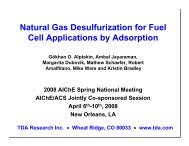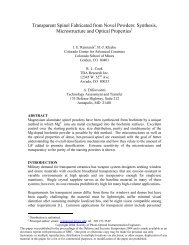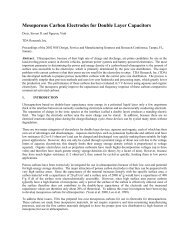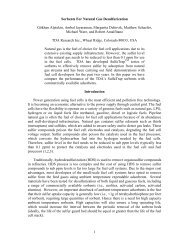Improved Electrodes for Capacitive Deionization - TDA Research, Inc.
Improved Electrodes for Capacitive Deionization - TDA Research, Inc.
Improved Electrodes for Capacitive Deionization - TDA Research, Inc.
Create successful ePaper yourself
Turn your PDF publications into a flip-book with our unique Google optimized e-Paper software.
<strong>Improved</strong> <strong>Electrodes</strong> <strong>for</strong><strong>Capacitive</strong> <strong>Deionization</strong>Dr. Steven Dietz2004 NSF Design, Service and Manufacturing Granteesand <strong>Research</strong> Conference, Birmingham, ALJanuary 2004<strong>TDA</strong> <strong>Research</strong> <strong>Inc</strong>. • Wheat Ridge, CO 80033 • www.tda.com
What is capacitive deionization?• Method <strong>for</strong> water desalination.• Operating principle• Liquid flows between high surface area electrodepairs having a potential difference of 1.2 v dc.• Ions and other charged particles are attracted andheld on the electrode of the opposite charge <strong>for</strong> laterrelease into a rinse stream.Active<strong>Electrodes</strong>PureWaterSaltyWater<strong>Electrodes</strong>RegenerationConcentratedBrine<strong>TDA</strong>R e s e a r c h
The Water CrisisSerious shortages now in Middle East and Africa. World Bank projects2.5 billion people by year 2025 will not have access to clean drinking water.<strong>TDA</strong>R e s e a r c h
<strong>Capacitive</strong> <strong>Deionization</strong> on PorousCarbon <strong>Electrodes</strong>Ions stored on the surface of the porous carbonThe more accessible surface area the more ionsthat can be stored.Farmer, J.C., D.V. Fix, G.V. Mack, R.W. Pekala and J.F. Poco (1996). J Electrochem. Soc. 143, 159-169.<strong>TDA</strong>R e s e a r c h
Previous Work• CDT developed at LLNL using carbonaerogel based electrodes.• CDT Systems, <strong>Inc</strong>. (Dallas TX) licensedtechnology.• Problems• Carbon aerogel synthesis is complicated and themain component (resorcinol) is too expensive <strong>for</strong>commercial production.<strong>TDA</strong>R e s e a r c h
Project Goals• Develop improved carbon electrodes <strong>for</strong>capacitive deionization• Approach:• Optimize the pore structure <strong>for</strong> ion removal• Reduce cost of carbons<strong>TDA</strong>R e s e a r c h
Ideal Pore Size Distribution <strong>for</strong>Carbon <strong>Electrodes</strong>• Mesopores (2 - 50 nm) <strong>for</strong> water access• Micropores (< 2 nm) <strong>for</strong> high surface area• Benefits:• <strong>Inc</strong>reased Capacity• Pores large enough <strong>for</strong> the ions to enter yet stillmaintain high surface areas.• <strong>Inc</strong>reased Rate• Large pores increase rate of ion transport throughthe electrode resulting in decreased ionicresistance.<strong>TDA</strong>R e s e a r c h
<strong>TDA</strong>’s Mesoporous Carbons• Carbon produced using conventionalproduction methods (no need <strong>for</strong>supercritical solvent extraction)• Production consists of two steps• Mixing solutions• Heat treatment• Materials costs are < $4/kg of carbon<strong>TDA</strong>R e s e a r c h
Typical Properties of <strong>TDA</strong> CarbonDensity(g/cm 3 )BJH AveragePore Size (nm)Total SurfaceArea (m 2 /g)Total PoreVolume (cc/g)MicroporeVolume (cc/g)0.5 4.0 600 0.3 0.2Mesopores allowaccess to highsurface areamicroporesNitrogen isotherm showing hysteresis due to mesopores.<strong>TDA</strong>R e s e a r c h
Electrode Screening• Two electrode 5 cm X 7.5 cm x 0.1 cm• 10,000 ppm NaCl• Charge/discharge 1.2 to 0 V• Amount of NaCl stored derived from thecumulative discharge energy calculatedfrom the discharge curve• E = V 2 /R x T where E = energy (J), V = voltage, R= resistance of the resistor (ohms), and T = time inseconds.<strong>TDA</strong>R e s e a r c h
Test Brick• Test long-termper<strong>for</strong>mance ofelectrodes• 24 electrodes(12” x 6”)<strong>TDA</strong>R e s e a r c h
Typical Charge-Discharge Curve1.41.21Voltage0.80.60.40.200:00 0:28 0:57 1:26 1:55 2:24 2:52 3:21 3:50 4:19Time (hours:minutes)<strong>TDA</strong>R e s e a r c h
Per<strong>for</strong>mance ComparisonCumulative Discharge Energy25<strong>TDA</strong>Cummulative Output Energy (J)2015105CDT00 200 400 600 800 1000 1200 1400 1600 1800 2000Time (sec)<strong>TDA</strong>R e s e a r c h
Summary of Results to Date• Comparison of <strong>TDA</strong> carbon electrodeswith CDT carbon aerogel electrodes• 45% increase in salt capacity• Factor of five decrease in materials cost• Factor of eight per<strong>for</strong>mance/cost increase<strong>TDA</strong>R e s e a r c h
Commercialization• Applied <strong>for</strong> patent on new carbons• Per<strong>for</strong>ming long-term studies using testbricks• Developing methods <strong>for</strong> production scaleup<strong>TDA</strong>R e s e a r c h














